Australia is a top destination for international students, offering world-class education and a vibrant cultural experience. However, understanding the cost of studying and living in Australia is crucial for effective planning. This guide breaks down the tuition fees, cost of living, and provides budgeting tips to help international students manage their finances.
1. Tuition Fees for Studying in Australia
Breakdown by Course and University
The tuition fees in Australia vary depending on the level of study, the university, and the specific course. Here’s an overview of typical fees:
Undergraduate Programs
- Public Universities: AUD 20,000 to AUD 45,000 per year
- Example: The University of Sydney charges around AUD 46,000 per year for most undergraduate programs.
- Private Universities: Slightly higher, ranging from AUD 30,000 to AUD 55,000 annually.
Postgraduate Programs (Master’s and PhD)
- Master’s Programs: AUD 22,000 to AUD 50,000 per year
- Example: The University of Melbourne’s business programs typically cost around AUD 44,000 per year.
- PhD Programs: AUD 20,000 to AUD 42,000 per year
- Example: The Australian National University offers PhD courses starting at AUD 40,000 annually.
Vocational Education and Training (VET)
- TAFE Courses: AUD 4,000 to AUD 22,000 annually
- VET courses in fields like hospitality, IT, and construction offer more affordable options, making them a popular choice.
MBA Programs
- Range: AUD 45,000 to AUD 90,000 total program cost
- Top Universities: The MBA at the University of Queensland costs around AUD 85,000.
Medical and Engineering Degrees
- Range: AUD 50,000 to AUD 80,000 per year
- These programs are generally the most expensive due to the resources and equipment required.
Scholarship Opportunities
Australian universities offer a range of scholarships to international students, which can significantly reduce tuition fees. Examples include:
- Australia Awards Scholarships: Full tuition and living expenses covered.
- University-specific Scholarships: The University of Melbourne and the University of Sydney, for instance, offer several merit-based scholarships for international students.
2. Cost of Living in Australia
The cost of living varies depending on the city and lifestyle. Below is a breakdown of living expenses in major Australian cities:
Sydney
- Rent: AUD 400 to AUD 650 per week for a one-bedroom apartment in the city center.
- Groceries: AUD 150 to AUD 250 per week.
- Public Transport: AUD 50 to AUD 70 per week.
- Overall Monthly Living Cost: AUD 2,200 to AUD 3,500.
Melbourne
- Rent: AUD 350 to AUD 600 per week.
- Groceries: AUD 120 to AUD 220 per week.
- Public Transport: AUD 40 to AUD 60 per week.
- Overall Monthly Living Cost: AUD 2,000 to AUD 3,200.
Brisbane
- Rent: AUD 300 to AUD 550 per week.
- Groceries: AUD 100 to AUD 200 per week.
- Public Transport: AUD 30 to AUD 50 per week.
- Overall Monthly Living Cost: AUD 1,800 to AUD 3,000.
Perth
- Rent: AUD 280 to AUD 500 per week.
- Groceries: AUD 100 to AUD 180 per week.
- Public Transport: AUD 30 to AUD 50 per week.
- Overall Monthly Living Cost: AUD 1,700 to AUD 2,900.
Adelaide
- Rent: AUD 250 to AUD 450 per week.
- Groceries: AUD 90 to AUD 160 per week.
- Public Transport: AUD 25 to AUD 40 per week.
- Overall Monthly Living Cost: AUD 1,500 to AUD 2,800.
3. Budgeting Tips for International Students
Managing finances effectively is essential for international students studying in Australia. Here are some practical budgeting tips:
3.1 Choose Affordable Accommodation
- Consider staying in university accommodations or shared apartments to lower your rent costs. Renting a room in shared housing can reduce expenses significantly, especially in big cities like Sydney and Melbourne.
- Opt for locations that are slightly away from the city center where rent is cheaper.
3.2 Take Advantage of Student Discounts
- Many public transport systems offer student discounts that can save you 30-50% on fares.
- Local businesses and cultural attractions often provide student rates for services like movie tickets, museum admissions, and food.
3.3 Cook at Home
- Cooking your own meals instead of eating out can significantly reduce your monthly grocery bills.
- Shop at budget supermarkets like Aldi, Coles, or Woolworths, and consider buying in bulk to save more.
3.4 Work Part-Time
- International students are allowed to work up to 48 hours per fortnight (during the semester) and unlimited hours during semester breaks. This can help cover living expenses and build work experience.
3.5 Use Free Resources
- Take advantage of free educational resources like university libraries and online platforms for study materials instead of purchasing expensive textbooks.
3.6 Monitor Your Spending
- Track your daily and monthly expenses using apps like Pocketbook or MoneyBrilliant. Keeping a budget will help you avoid unnecessary expenses and save for larger payments like tuition.
3.7 Health Insurance
- International students in Australia are required to have Overseas Student Health Cover (OSHC). Shop around for affordable health insurance providers to ensure you get a good deal on your medical coverage.
Final Thoughts
Australia offers a rewarding educational experience, but careful financial planning is crucial for international students. Understanding the cost of tuition and living in major cities like Sydney, Melbourne, and Brisbane, along with budgeting tips, can make a big difference in your overall experience. With scholarships, part-time work, and smart financial management, you can make your study abroad journey more affordable and enjoyable.
🌏🎓 Here’s Your Step-by-Step Guide! 🇦🇺✈️







